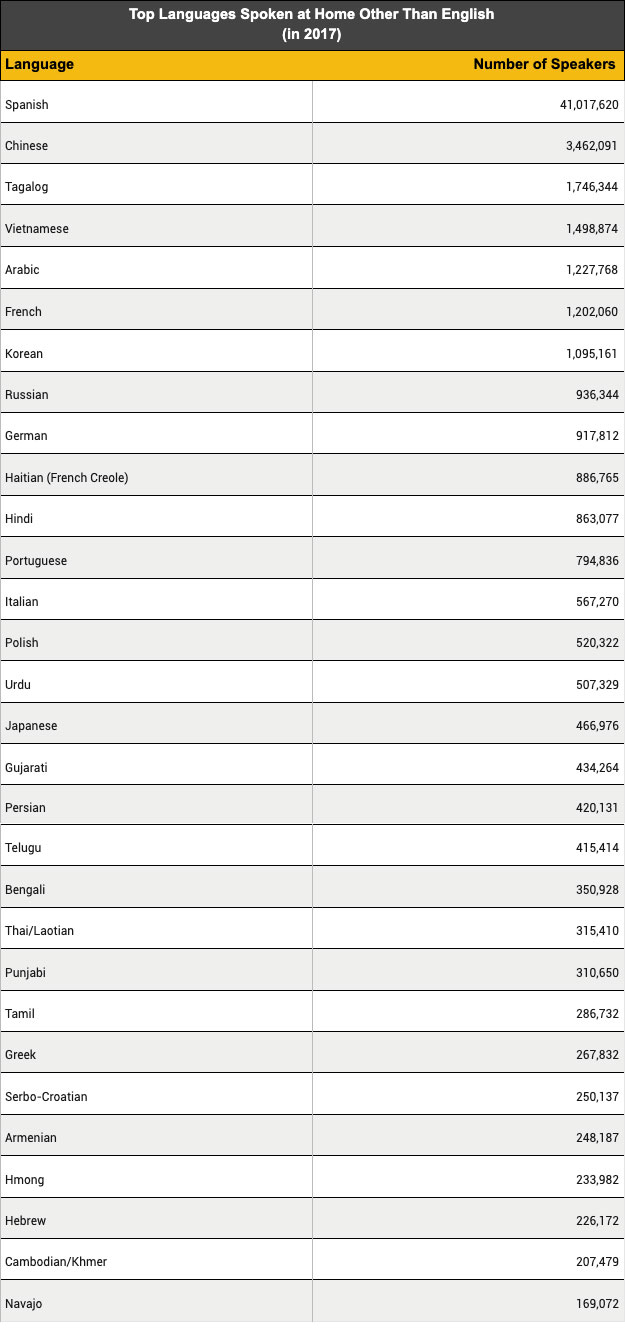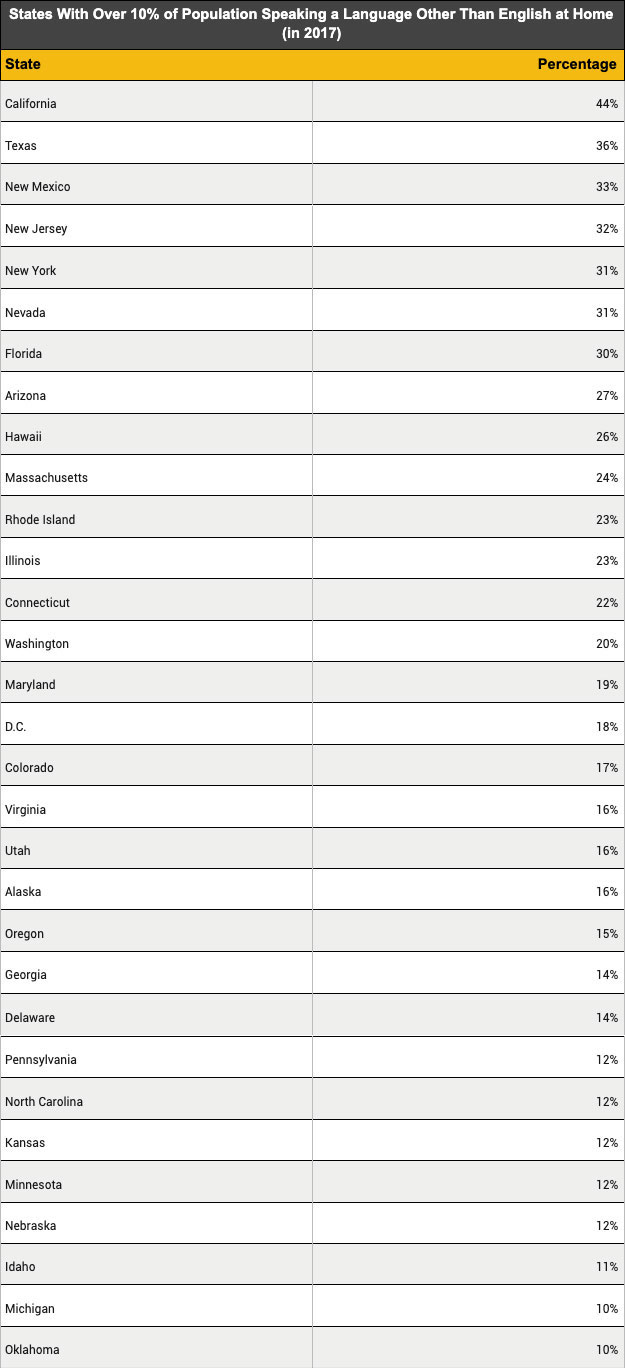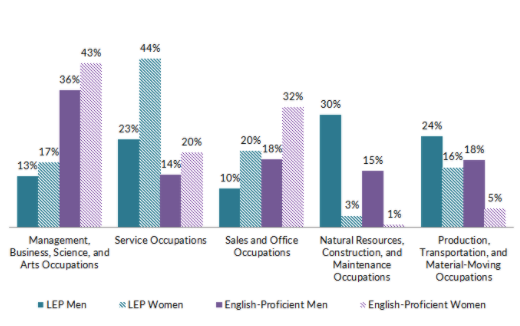Apr 20, 2021
US Immigration and Language Diversity Trends That Affect Businesses
6 min read
The United States has more immigrants than any other country in the world, and this is a fact businesses should embrace rather than ignore.
Diversity trends are important for businesses to consider as population changes influence changes in audience demographics.
As the impact of immigration on the US continues to grow, businesses across the nation need to consider how to communicate with multicultural audiences and overcome powerful language barriers.
Choosing to delay adjusting for diversity increases the chances of making a mistake due to miscommunication with clients. Small mistakes can offend clients or make a business appear less credible; large mistakes can end up harming clients and damaging reputations, creating more risk for a business. And, even if a representative manages to communicate formally and without error, it’s likely that communication difficulties and differences will leave people feeling less connected to you as a provider.
All of the above contribute to increased risk and a widespread loss of customers without the reputation to draw in new ones, especially compared to competitors who welcome cultural differences.
Without the ability to communicate with linguistically diverse clients, the growth of a company is needlessly threatened by the risks that come with miscommunication. The hazardous situation only magnifies as immigration continues to make up a greater portion of the US population and the number of clients who speak foreign languages increases.
Adapting to immigration and language diversity trends is crucial for all businesses, but it is especially vital for businesses who work in service industries. Otherwise, you’re putting multicultural populations at a disadvantage when interacting with your business. The repercussions of this can be severe in areas like healthcare where miscommunication can result in misdiagnosis and medical malpractice in a life or death situation.
It’s better to place yourself in a position for success while contributing to equality within your industry. And the best place to start is with an understanding of current immigration and language trends.
Immigration Trends: Growing Diversity in the US
Immigrants account for more than 13.5% of the US population, and that number continues to grow as about 3,100 foreigners receive immigrant visas or green cards each day. This equates to over one million immigrants entering the US a year.
Currently, 25% of the 44.8 million foreign-born people living in the US are from Mexico – but times are changing.
Of immigrants entering the US in 2018, most came from China, with 149,000 people. This was followed by India with 129,000 people, Mexico with 120,000 people and the Philippines with 46,000 people.
Looking to the future, experts expect immigrants and their descendants to account for 88% of US population growth through 2065.
Understanding Language Diversity and Limited English Proficiency
While language diversity in the US has fluctuated over time, many don’t realize how diverse America was from the start. Studies suggest that at the time of American independence, English wasn’t even the primary language for over a third of the population.
Since then, the prevalence of English grew, and language diversity in the US has been primarily driven by immigration.
Right now, there are over 350 languages spoken in the country, and nearly 67 million people speak a language other than English at home. That adds up to about 20% of the population – triple the amount in 1980.
Businesses have scrambled to account for this influx of diversity, but it’s been far from enough to account for the true extent of change. For example, some large companies offer customer service in Spanish. But is this enough to account for the over 41 million native Spanish speakers in the country?
The Chinese, Vietnamese, Tagalog, Arabic, French and Korean languages also have over a million native speakers in the US as of 2017. Meanwhile, Hindi, German and Russian speakers are nearing the one million mark as well.

Data from the Center for Immigration Studies.
In some states, a high percentage of the population speaks a language other than English at home. Prime examples are California (44%), Texas (36%), New Mexico (33%), New Jersey (32%), New York (31%), Nevada (31%) and Florida (30%).

Data from the Center for Immigration Studies.
So, is only offering interpreters for customer service really enough? And are enough companies accounting for this level of diversity?
Insight on LEP Individuals
LEP stands for Limited English Proficiency or Limited English Proficient and describes individuals who speak English less than “very well.”
Of the US population members who speak a foreign language at home, 39% (26 million individuals) consider themselves to be LEP. That equates to 9% of the total US population.
So, where do these people live?
Immigrants and LEP speakers, though spread throughout the US, live largely in metropolitan areas. In fact, according to the 2017 Census Bureau, a whopping 48.2% of people in America’s five largest cities speak a language other than English at home. That’s near half of their population.
The linguistic diversity of LEP speakers also fluctuates state by state, typical of the varied demographics throughout the nation. This means that the foreign languages that dominate an area vary by state. For example, the top languages spoken by LEP residents in Maine are French, Spanish and Cushite; in New York are Spanish, Chinese and Russian; and in Hawaii are Ilocano, Tagalog and Chinese.
Businesses should also be aware that LEP individuals are more likely to work in certain industries than non-LEP individuals. These include service, natural resources, construction, maintenance, production, transportation and material moving occupations.

Chart from the Migration Policy Institute.
This is relevant data for any business working to better understand and target their audience. It also has special implications for workers’ compensation, insurance and health industries because these occupations are more likely to sustain injuries than standard office jobs.
Communicating with LEP Clients and Customers
It’s easy to hope that LEP audience members will learn English while living in the US so that you don’t have to meet them halfway. The truth is that 75% of LEP speakers are between the ages of 18 and 64, and the effort required to learn a new language escalates rapidly after the age of 18.
This means that very few of these LEP speakers will take the time to become proficient in English, and even those who moved to the US early enough to learn will be more comfortable with their first language. Thus, your business would do well to reap the benefits of learning how to communicate with multicultural consumers. This includes the ability to serve a larger client base.
Making linguistic diversity a part of your service also allows you to serve your clients better. For one, it accounts for significant cultural differences in nuance, phrasing and body language. This empowers you to fully and correctly understand your clients’ situations and provide the best outcome. It also prevents misunderstandings when drafting business deals and contracts, so you both know what you’re getting into.
Proper communication is especially valuable in situations where details matter, such as in legal and healthcare practices. It mitigates risks by ensuring that you provide proper treatment and represent your client the way they deserve. It also protects your business from the damage, time and cost of a woeful mistake.
And, just like with any other client, effective communication builds trust and allows for a deeper connection that better serves both parties.
So, how do you communicate with a large and growing number of LEP clients?
Interpreters and translators are able to help you and your employees communicate with multicultural people and LEP speakers. Fluent in English and your client’s language, they translate for both parties and prevent miscommunication from occurring, increasing productivity as a result.
Interpreters also come with a knowledge of your client’s cultural background so that they can eliminate the risk of offending someone. And, by speaking their native language, professional interpreters can even help you develop those meaningful client connections.
Nowadays, you can get a variety of secure, HIPAA-compliant interpretation services, including document translation, on-site interpretation, telephonic interpretation and video remote interpretation. Video interpreters are a great resource for businesses that have long-distance clients, are social distancing, or want to take advantage of the digital age.
Interested in making your business more welcoming, inclusive and competitive? Reach out to the translation and interpretation experts at iLingo2.